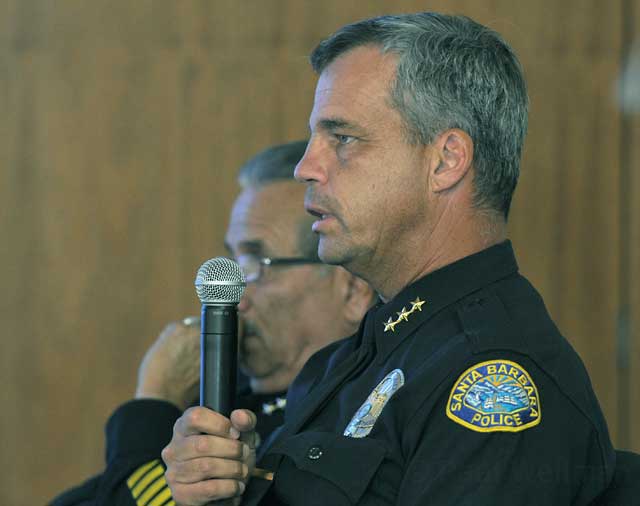Crunched by Numbers
Crime Down, Call for Cops Up

Setting the stage for many showdowns yet to come, Santa Barbara City Councilmember Dale Francisco declared the State of California was bankrupt because elected officials, serving the interest of the public employee unions that bankrolled their campaigns, approved spending levels that were simply not sustainable. “Bankrupt, that’s what we are,” said Francisco, visibly trembling and red of face. “Fifty years of mismanagement will do it; that’s what it took to wreck the Golden State.” Francisco’s remarks came at the tail end of what was the first of many special sessions to hash out the city’s budget, now weighing in with a $3-million shortfall. (By contrast, last year’s budget gap was $9 million.) Francisco — up for reelection this November and clearly the most politically strategic of the council’s new conservative majority — argued that City Hall needed to increase the authorized number of cops in uniform, but set no specific number. “Everything else is a luxury,” he declared. (His council colleague and fellow conservative Frank Hotchkiss had set the goal in previous interviews at 10 new cops.) Francisco noted that City Hall is well stocked with city planners, and suggested that City Hall’s trash and environmental services might replicate services provided by the county. And no more work furlough days, he said. They serve to shortchange consumers of city services, he said, while allowing city workers to continue to enjoy unsustainably large salaries.
But just how many cops the city currently needs and how much it can afford remain the million-dollar questions. Assistant Chief Frank Mannix declared there was no correlation between the number of cops and sworn officers. Currently, the department is authorized to have 137 sworn officers, but the actual number is closer to 118. That gap reflects retirement, turnover, and attrition; it also reflects the time it takes to get prospective new cops background-
checked and through the academy and field training. Mannix noted that 11 new officers will be hitting the streets within the next 12 months. Despite the relative paucity of cops on patrol, Mannix said that crime has dropped 11 percent overall in Santa Barbara the past year, and serious crime by the same amount. Only grand theft auto, he said, went up, and that by 14 percent. Gang-related crime — and what that means is hard to define — went up by 23 percent in the last year, Mannix said, but he cautioned that the increase actually included a decrease by 14 percent in gang-related violent crime, which was more than offset by a “bloom” of gang-related misdemeanors.
Mayor Helene Schneider argued the 11 additional police officers will help plug many of the gaps in service caused by year after year of budget woes. Francisco remained adamant, however, that simply more cops would not be sufficient; City Hall had to increase the actual number of authorized positions. “All these new jobs don’t necessarily need to be done by a badge,” he said, “but they need a person.” With salary, benefits, and a pension, a typical cop costs $150,000 a year. Ten new cops would cost City Hall $1.5 million a year. When asked where this money would come from, Francisco and his conservative colleagues have been quick to suggest city traffic engineers and planners could be sacrificed for the higher goal of increased public safety. In private conversations, Councilmember Bendy White noted that traffic engineers are not paid out of the city’s General Fund — the pot of gold that sustains police, fire, library, and parks services — and that roughly 40 percent of planners’ salaries derive from various processing and review fees. To fund new cops, he estimated, would require cutting 25 full-time positions in other departments.
Last week’s special meeting was the earliest in the year the council had met to discuss its upcoming budgets. Typically, the first such meeting occurs sometime in April. This year, at the instigation of Francisco, the council got a jump on the process so that the elected officials would define budget priorities to staff, not the other way around.


